NEW YORK ANGLER MAGAZINE
Professional Fishing Technology & Techniques
Professional Fishing Technology & Techniques
The Future is Now: Forward-Facing Sonar Revolutionizes Blackfish Targeting in New York Waters
How Live Imaging Technology is Transforming Tautog Fishing for the Modern Angler
By George | Photography by New York Angler Staff
Published in New York Angler Magazine
Published in New York Angler Magazine
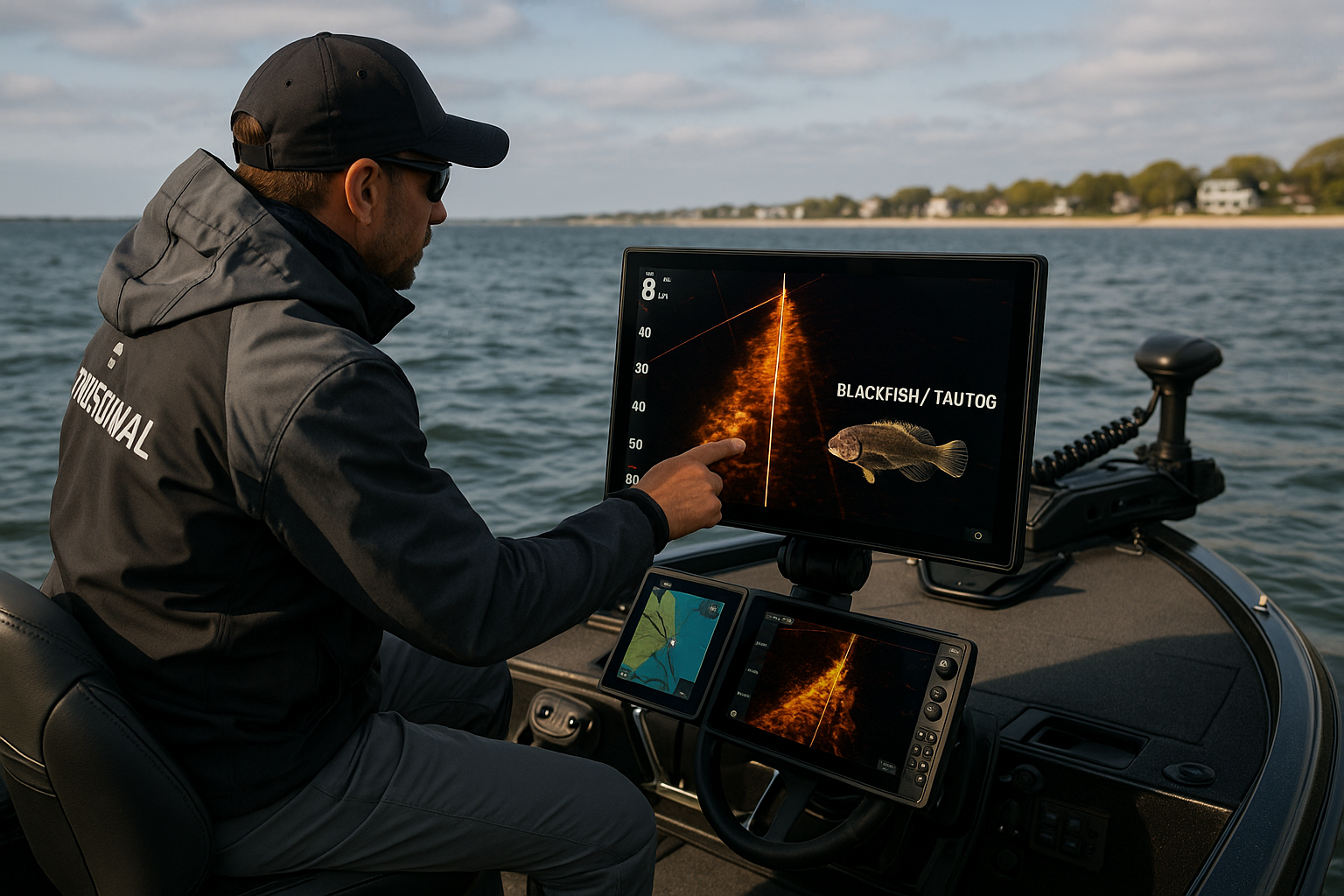
Caption: Modern forward-facing sonar technology allows anglers to see blackfish in real-time as they relate to structure, revolutionizing traditional bottom fishing approaches.
Introduction: A New Era of Precision Fishing
The blackfish bite in New York waters has always been a game of patience, persistence, and intimate knowledge of structure. For generations, successful tautog anglers have relied on their understanding of underwater topography, seasonal patterns, and subtle changes in their tackle to locate these prized bottom dwellers. Today, forward-facing sonar (FFS) technology is fundamentally changing how we approach blackfish fishing, offering unprecedented real-time visibility into the underwater world where these structure-loving fish make their home.
Forward-facing sonar represents the most significant advancement in fishing electronics since the introduction of GPS chartplotters. While traditional sonar shows what's directly beneath your boat, FFS technology projects a cone of sound waves forward and to the sides, creating a live video-like image of fish, structure, and your bait up to 200 feet away. For blackfish anglers fishing the rocky bottoms, wrecks, and artificial reefs throughout New York's coastal waters, this technology offers game-changing advantages.
Forward-facing sonar represents the most significant advancement in fishing electronics since the introduction of GPS chartplotters. While traditional sonar shows what's directly beneath your boat, FFS technology projects a cone of sound waves forward and to the sides, creating a live video-like image of fish, structure, and your bait up to 200 feet away. For blackfish anglers fishing the rocky bottoms, wrecks, and artificial reefs throughout New York's coastal waters, this technology offers game-changing advantages.

Caption: Traditional sonar (left) only shows what's directly below the boat, while forward-facing sonar (right) provides a forward-looking view up to 200 feet ahead.
Understanding Forward-Facing Sonar Technology
Forward-facing sonar systems use advanced CHIRP (Compressed High-Intensity Radiated Pulse) technology combined with sophisticated signal processing to create real-time images of the water column ahead of your boat. The transducer, typically mounted on a trolling motor or through-hull installation, can be adjusted to scan different depths and distances.
Key Technical Specifications
- Range: 5-200+ feet forward distance
- Frequency: 455-800 kHz depending on system
- Update Rate: 16-20 times per second for real-time imaging
- Beam Angle: Typically 20-30 degrees wide
- Depth Capability: 2-300+ feet depending on conditions
The system works by transmitting sound pulses in a forward-facing pattern, then processing the returned echoes to create a detailed image. Unlike traditional sonar that shows historical data as you pass over structure, FFS shows what's happening in real-time, allowing you to watch fish behavior, see your bait presentation, and observe how blackfish respond to your offerings.
Applications for Blackfish Fishing
Blackfish fishing in New York waters presents unique challenges that forward-facing sonar is perfectly suited to address. These fish are notorious for their tight relationship with structure – they don't just relate to it, they live in it. Traditional fishing methods often result in countless snags and lost rigs as anglers blindly probe rocky bottoms and wreck sites.
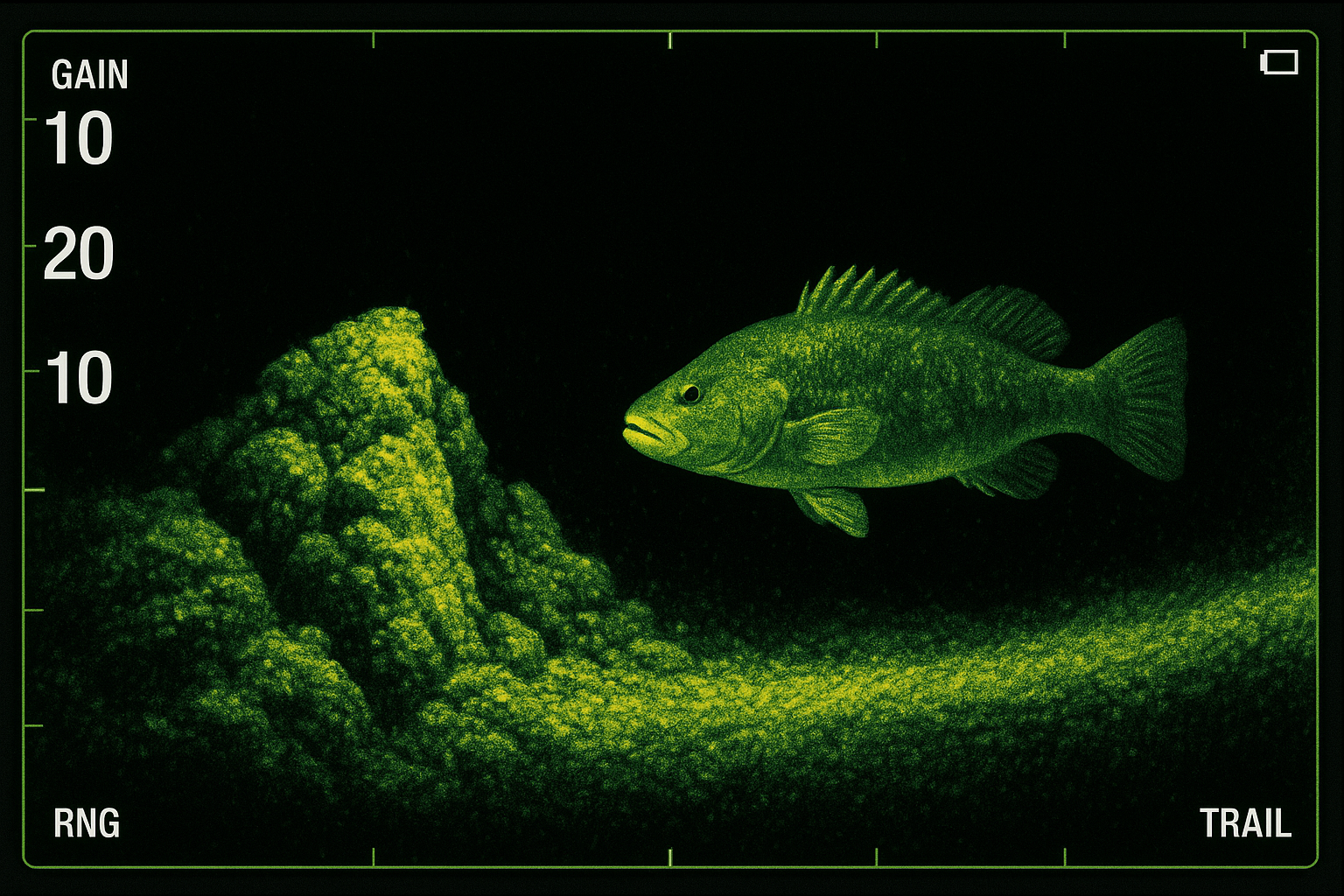
Caption: This forward-facing sonar image shows multiple blackfish (bright arches) positioned around a wreck structure at 45 feet, allowing precise bait placement.
Structure Identification and Navigation
FFS excels at helping anglers identify productive blackfish structure before positioning the boat. You can scan ahead to locate the specific rocks, ledges, or wreck features that are most likely to hold fish. More importantly, you can identify the edges and openings where you can present baits without immediately snagging bottom.
Captain Rich Jensen, who has been targeting blackfish in Long Island Sound for nearly 50 years, explains the advantage: "With forward-facing sonar, I can see exactly where the fish are positioned on the structure and identify the best approach angle. Instead of anchoring and hoping, I can position my boat to present baits in the most productive zones while avoiding the worst snag areas."
Captain Rich Jensen, who has been targeting blackfish in Long Island Sound for nearly 50 years, explains the advantage: "With forward-facing sonar, I can see exactly where the fish are positioned on the structure and identify the best approach angle. Instead of anchoring and hoping, I can position my boat to present baits in the most productive zones while avoiding the worst snag areas."
Real-Time Fish Behavior Observation
Perhaps the most revolutionary aspect of FFS for blackfish fishing is the ability to observe fish behavior in real-time. Blackfish are often described as finicky feeders, but FFS reveals they're actually quite active when undisturbed. Anglers can watch fish move in and out of structure, observe their feeding patterns, and adjust their presentation accordingly.
Case Study: Montauk Point Success
Location: Rocky structure east of Montauk Point Light
Conditions: 35-foot depth, moderate current
Results: 12 keeper blackfish in 3 hours
Using forward-facing sonar, angler John McCarthy identified a previously unknown rock pile holding multiple blackfish. "I could see groups of 4-6 fish moving around the structure," McCarthy reported. "The sonar showed me exactly where to drop my bait – not on top of the rocks where I'd snag, but in the sandy pockets where the fish were feeding. I watched them approach my bait multiple times before getting the right presentation."
Conditions: 35-foot depth, moderate current
Results: 12 keeper blackfish in 3 hours
Using forward-facing sonar, angler John McCarthy identified a previously unknown rock pile holding multiple blackfish. "I could see groups of 4-6 fish moving around the structure," McCarthy reported. "The sonar showed me exactly where to drop my bait – not on top of the rocks where I'd snag, but in the sandy pockets where the fish were feeding. I watched them approach my bait multiple times before getting the right presentation."
System Comparison: Choosing the Right FFS
Three major manufacturers currently dominate the forward-facing sonar market, each offering distinct advantages for blackfish fishing applications.
| Garmin LiveScope | 200+ feet | Excellent detail | Structure fishing, fish ID | $2,500-$4,000 |
| Lowrance ActiveTarget | 150+ feet | High contrast | Deep water, current | $2,200-$3,500 |
| Humminbird MegaLive | 125+ feet | Good detail | Budget-conscious, versatile | $1,800-$3,000 |
[th]
System
[/th][th]Range
[/th][th]Image Quality
[/th][th]Best For
[/th][th]Price Range
[/th]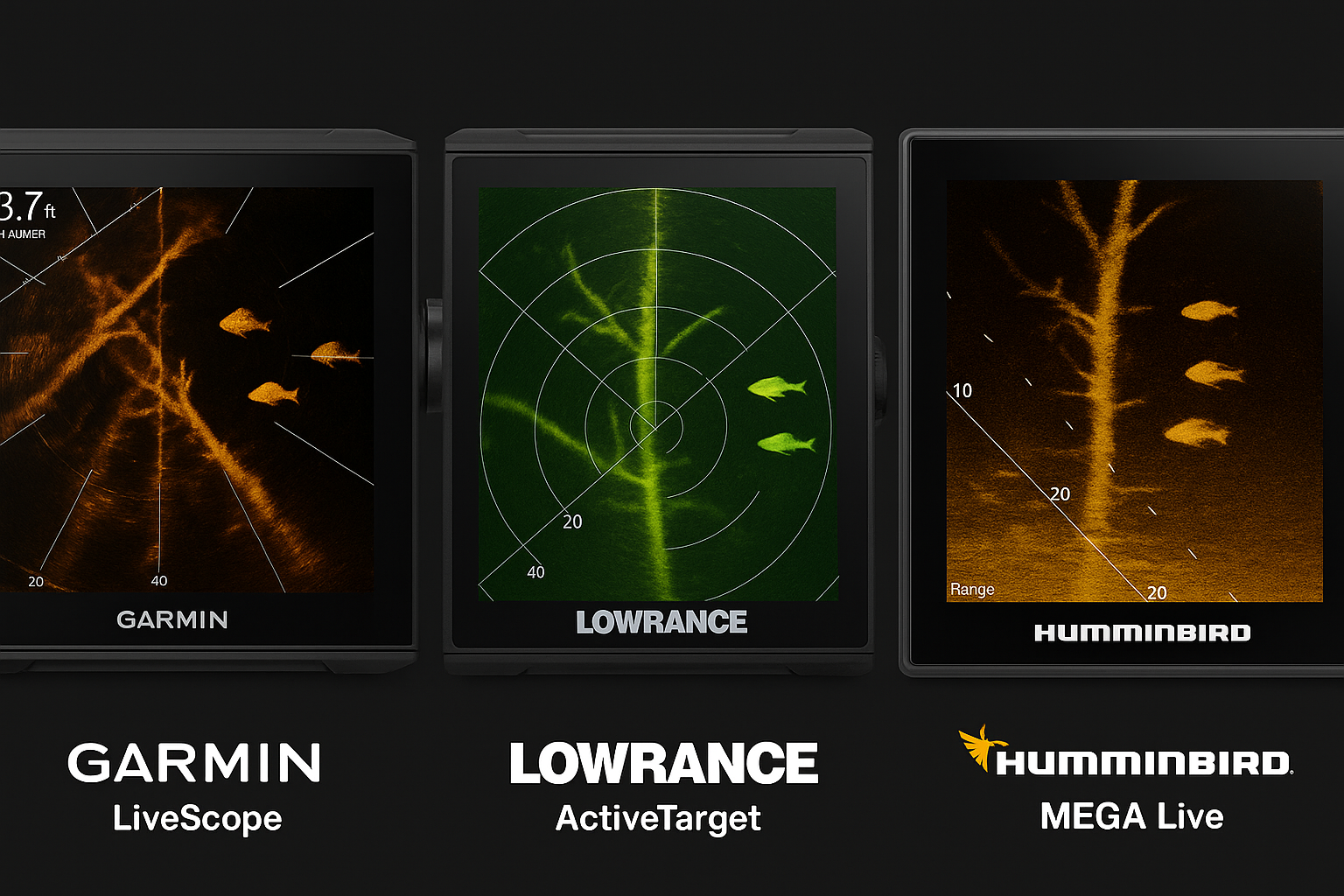
Caption: Comparison of image quality from Garmin LiveScope (left), Lowrance ActiveTarget (center), and Humminbird MegaLive (right) showing the same blackfish structure.
Garmin LiveScope System
Garmin's LiveScope technology offers exceptional image clarity and the longest range capabilities. The system excels at distinguishing individual fish from structure, making it particularly valuable for blackfish fishing where fish often hold tight to rocks and debris. The newest LiveScope Plus systems offer improved resolution and faster update rates.
Lowrance ActiveTarget
ActiveTarget systems provide excellent performance in deeper water and strong current conditions common in New York's offshore blackfish grounds. The high-contrast imaging makes it easier to track baits and identify fish in challenging conditions. The system's integration with Lowrance's HDS displays offers seamless operation.
Humminbird MegaLive
MegaLive represents the most budget-friendly entry into forward-facing sonar technology while still providing effective fish-finding capabilities. The system offers good versatility for anglers who target multiple species beyond blackfish.
Techniques and Tips for New York Anglers
Essential FFS Blackfish Techniques
- Scan Before Anchoring: Use FFS to locate active fish before committing to a fishing position
- Watch Bait Presentation: Observe how your bait behaves in the current and around structure
- Track Fish Movement: Monitor fish activity levels throughout the tide cycle
- Identify Feeding Zones: Look for areas where fish move away from structure to feed
- Avoid Spooking Fish: Use quiet trolling motor operation when repositioning
Optimal Settings for Blackfish Fishing
Success with FFS requires proper system setup for blackfish fishing conditions. In the typically 15-60 foot depths where New York blackfish are found, use a range setting of 80-120 feet to provide adequate forward scanning distance. Sensitivity should be adjusted to clearly show structure while minimizing noise from particles in the water column.
For fishing around wrecks and artificial reefs, use the narrow beam setting for maximum detail when available. When fishing natural rock formations or boulder fields, the wide beam setting can help identify the most productive areas more quickly.
For fishing around wrecks and artificial reefs, use the narrow beam setting for maximum detail when available. When fishing natural rock formations or boulder fields, the wide beam setting can help identify the most productive areas more quickly.
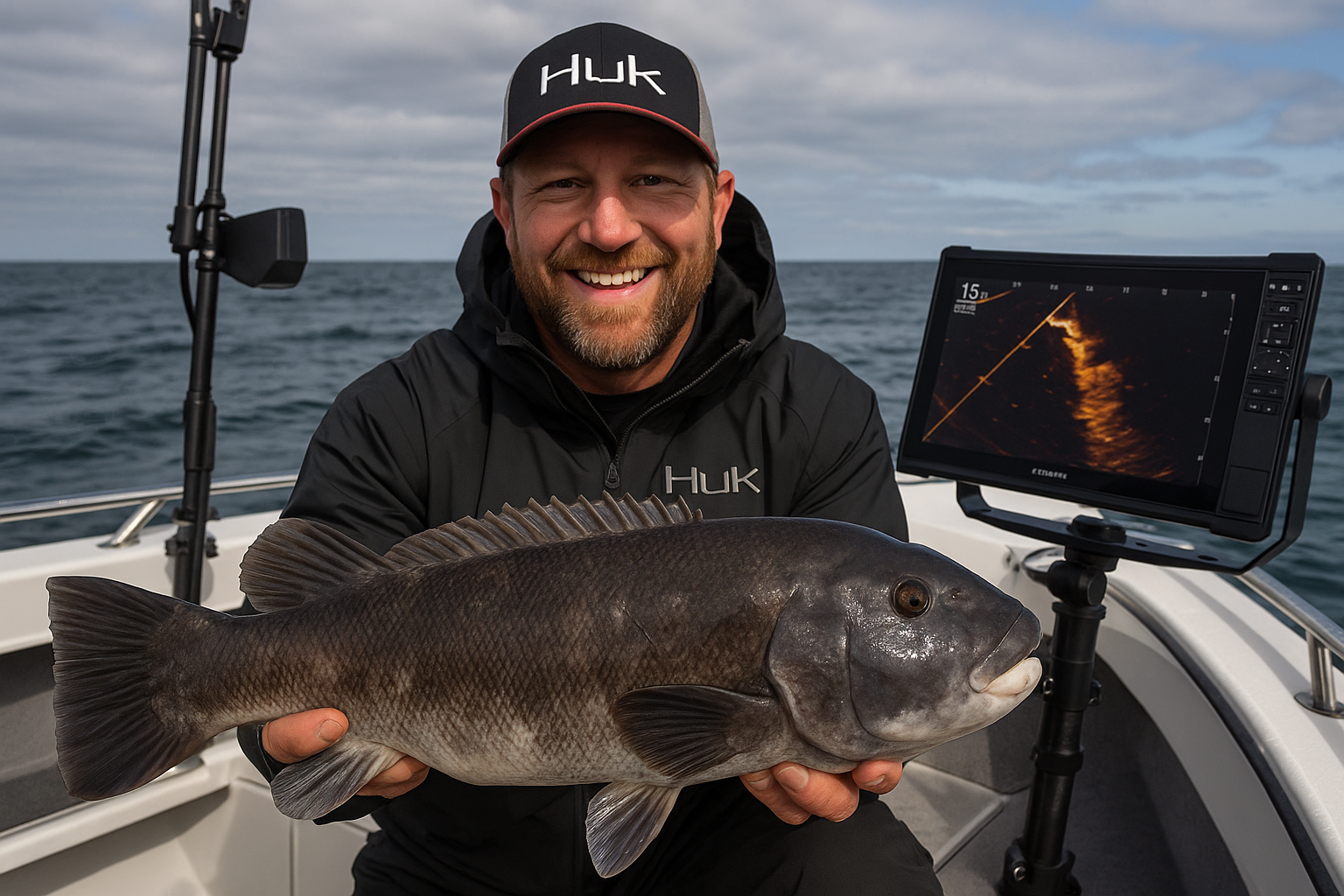
Caption: Forward-facing sonar doesn't replace fishing skill – it enhances it, allowing anglers to make more informed decisions about bait placement and presentation.
Reading Blackfish on FFS Displays
Blackfish appear as distinct arches or elongated marks on FFS displays, typically positioned very close to structure. Unlike more pelagic species that may suspend in the water column, blackfish almost always appear within a few feet of bottom structure. Large blackfish often appear as more pronounced, wider marks compared to smaller fish.
Active feeding blackfish may appear to move frequently between different areas of structure, while inactive fish often remain stationary for extended periods. The ability to distinguish between active and inactive fish allows anglers to focus their efforts on the most productive areas.
Active feeding blackfish may appear to move frequently between different areas of structure, while inactive fish often remain stationary for extended periods. The ability to distinguish between active and inactive fish allows anglers to focus their efforts on the most productive areas.
Future Innovations and Potential
The forward-facing sonar technology continues to evolve rapidly, with manufacturers introducing new features specifically beneficial for structure fishing applications like blackfish targeting.
Emerging Technologies
Recent developments include improved transducer designs that provide better resolution at close range – particularly valuable when fishing tight to structure. Enhanced signal processing algorithms are improving fish identification capabilities, helping anglers distinguish blackfish from other bottom species.
Multi-frequency systems are becoming more common, allowing anglers to optimize performance for specific fishing conditions. Integration with artificial intelligence and machine learning promises even more sophisticated fish identification and behavior analysis capabilities.
Multi-frequency systems are becoming more common, allowing anglers to optimize performance for specific fishing conditions. Integration with artificial intelligence and machine learning promises even more sophisticated fish identification and behavior analysis capabilities.
Looking Ahead: Next-Generation Features
- 3D Imaging: True three-dimensional underwater visualization
- Species Recognition: AI-powered fish species identification
- Behavioral Analysis: Automated feeding behavior detection
- Predictive Modeling: Advanced algorithms predicting fish movement
- Cloud Integration: Sharing productive fishing locations and conditions
Impact on Fishing Practices
As FFS technology becomes more widespread and affordable, it's likely to fundamentally change how blackfish fishing is approached in New York waters. The technology enables more precise fishing, potentially reducing the environmental impact of lost tackle while improving catch rates.
Educational opportunities abound as anglers gain direct observation of fish behavior that was previously impossible to witness. This real-time feedback loop accelerates learning and skill development, particularly for newer anglers learning to target blackfish.
Educational opportunities abound as anglers gain direct observation of fish behavior that was previously impossible to witness. This real-time feedback loop accelerates learning and skill development, particularly for newer anglers learning to target blackfish.
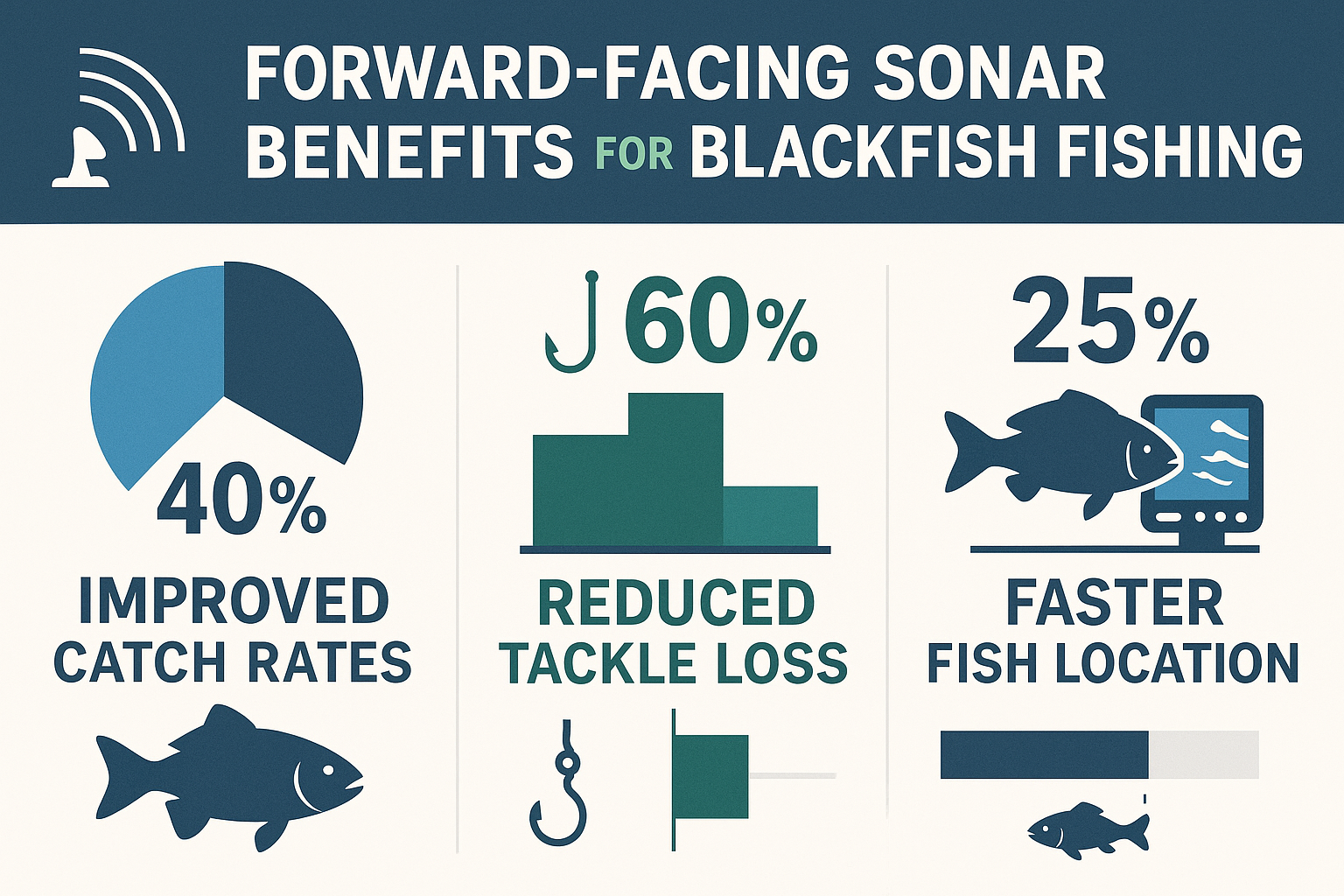
Caption: Data from New York charter captains shows significant improvements in both catch rates and tackle conservation when using forward-facing sonar technology.
Conclusion: Embracing the Technology Revolution
Forward-facing sonar represents more than just another fishing gadget – it's a fundamental shift in how we approach and understand blackfish fishing. For New York anglers who have spent decades mastering the traditional techniques of structure fishing, FFS offers the opportunity to take their skills to an entirely new level.
The technology doesn't replace the need for fishing knowledge, proper tackle selection, or understanding of blackfish behavior and seasonal patterns. Instead, it enhances these traditional skills by providing unprecedented insight into the underwater world where blackfish live. The angler who combines traditional knowledge with modern FFS technology possesses a significant advantage in consistently locating and catching these prized fish.
As we look toward the future of blackfish fishing in New York waters, forward-facing sonar stands as a perfect example of how technology can enhance rather than replace traditional angling skills. The most successful blackfish anglers of tomorrow will be those who embrace these technological advances while maintaining the patience, persistence, and respect for these magnificent fish that has always defined great blackfish fishing.
Whether you're a weekend warrior targeting blackfish off Long Island's south shore or a serious angler working the deep structures around Montauk Point, forward-facing sonar technology offers the potential to transform your fishing experience. The future of blackfish fishing in New York waters is here – and it's looking better than ever.
The technology doesn't replace the need for fishing knowledge, proper tackle selection, or understanding of blackfish behavior and seasonal patterns. Instead, it enhances these traditional skills by providing unprecedented insight into the underwater world where blackfish live. The angler who combines traditional knowledge with modern FFS technology possesses a significant advantage in consistently locating and catching these prized fish.
As we look toward the future of blackfish fishing in New York waters, forward-facing sonar stands as a perfect example of how technology can enhance rather than replace traditional angling skills. The most successful blackfish anglers of tomorrow will be those who embrace these technological advances while maintaining the patience, persistence, and respect for these magnificent fish that has always defined great blackfish fishing.
Whether you're a weekend warrior targeting blackfish off Long Island's south shore or a serious angler working the deep structures around Montauk Point, forward-facing sonar technology offers the potential to transform your fishing experience. The future of blackfish fishing in New York waters is here – and it's looking better than ever.
Caption: The combination of traditional blackfish fishing knowledge and modern forward-facing sonar technology represents the future of successful tautog fishing in New York waters.
For more cutting-edge fishing techniques and technology reviews, visit NewYorkAngler.com
For more cutting-edge fishing techniques and technology reviews, visit NewYorkAngler.com

